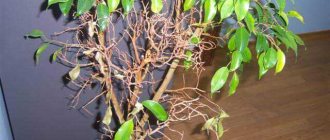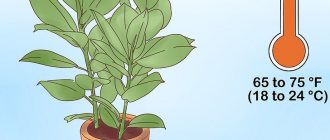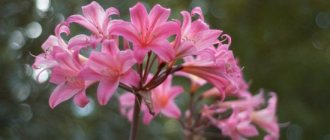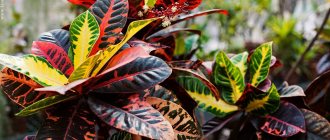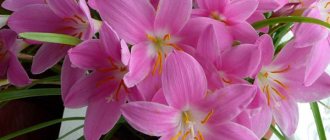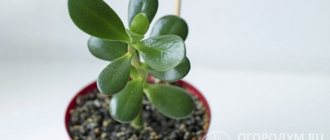Conditions for growing at home
Illumination
Cyclamen loves light, but not hot direct rays. On window sills on the south side it requires shading, so the plant will do better near southwestern, western or eastern windows with bright, diffused light. In summer, cyclamen is transferred to the balcony or garden terrace, to a shaded place.
Temperature
The culture does not tolerate high air temperatures. Optimal parameters for growth and development are 12-15°C. It reacts negatively to temperature increases above 18-20°C. At higher temperatures and dry air, you need to increase the humidity so that the plant does not die. The pots are placed in trays with wet expanded clay or pebbles, or the air around the plants is periodically sprayed. Cyclamen should not be placed near radiators or other heating devices.
The soil
A light nutrient substrate that allows water and air to pass through well is suitable for planting. The soil mixture is prepared from equal parts of leaf soil, humus, sand and peat. You can purchase ready-made soil specifically for cyclamen in the store. The soil acidity level for cyclamens should be 5.5–6.5pH.
Useful video
Watch a video about fertilizers for cyclamen:
On our portal you will find other tips on growing cyclamen at home. Read about the rules for caring for a flower after purchase and the intricacies of replanting a plant.
Growing from seeds
Cyclamen seeds
Cyclamen grown from seeds is more hardy than a ready-made specimen from the store. From birth he is adapted to the conditions of the home environment.
You can sow cyclamens all year round, but the best period is February-March. At this time, daylight hours increase and seedlings do not need additional lighting.
Containers and loose soil for crops are prepared in advance. Cyclamen seeds are large, with a dense skin. They are first soaked for a day in water or a solution of growth stimulants. Then they are embedded in a damp substrate to a depth of 0.5 cm. The containers are covered with film to keep the soil moist. The crops are ventilated daily and checked for seedlings. They germinate unevenly, with the first seedlings appearing within 2-4 weeks. Favorable conditions are created for young plants: they select a well-lit place, control soil moisture, preventing drying out, and make sure that young nodules are completely covered with soil. The cover from the crops is removed when they get stronger and fully expand their leaves. During this period, within 1-2 months, the root system of cyclamen intensively develops. Through the walls of the transparent containers you can see how the roots are gradually filling the soil, which means it’s time to plant the plants.
It is convenient to plant seedlings in 200 ml plastic cups. A drainage hole is made at the bottom, then they are filled with nutritious, moist soil. Before picking, the plants are watered, one at a time removed from the common nursery and transplanted into cups. The first time after picking, the seedlings are watered when the soil dries out a little. For normal growth, cyclamens are provided with the necessary conditions: diffused sunlight, coolness, watering and fertilizing. The growing season of indoor cyclamens lasts 10-12 months. Therefore, if sowing was carried out, for example, in February, then a year later you can get a flowering plant.
Transfer
The new pot for replanting should be larger than the previous one and have drainage holes. You can buy soil for replanting or prepare it yourself according to the following recipe:
- ½ Humus and sand.
- ½ turf or deciduous soil.
The transplant is performed in 6 stages:
- Cyclamen is removed from the container along with the soil.
- The root is shaken off and washed under cool water.
- Inspect for damage, rot and mold on the tuber. If there are damaged areas, they are cut off and the cut areas are sprinkled with crushed coal.
- The finished mixture is poured into the pot 1/3 full.
- Insert the plant and fill it to the edges of the pot.
- Water the soil and spray the leaves.
Transplantation is performed every 4-5 years. The best time is early March.
Do you want to buy cyclamen?
Terry varieties of cyclanene
In order for cyclamen to become a long-liver at home, when purchasing, you need to choose the right healthy specimen. Don’t be afraid to be picky, because often a ready-made plant from a store begins to act up and dies. What should you pay attention to first?
- The plant should not be over-watered. If the pot is heavy and water is leaking from the bottom, it is possible that this watering regime is common practice in this store. Excess moisture is detrimental to the tuber. It’s better not to risk it and buy a flower elsewhere.
- The root system must be healthy without soft parts. By lifting the pot with the plant, you can assess its condition. The presence of many elastic white roots protruding from the drainage holes is a good sign.
- The plant should not have yellow, limp or spotted leaves. You should refuse to purchase such copies, even if they are sold at a deep discount. It is unlikely that you will be able to make friends with these cyclamens.
- A healthy cyclamen tuber is hard on all sides. If the plant has a lot of buds and young leaves, this also confirms the viability of the tuber.
Ready-made cyclamens are usually purchased in late autumn or winter, so they are well packaged in the store so that the plants do not die during transportation due to the cold.
In order for the flower to better adapt at home, it needs to be replanted from store-bought soil as soon as possible. If this cannot be done in a short time, then the top of the tuber is freed from the soil and placed in a cool place. During this period, you need to be careful with watering, since store-bought cyclamens are sold in peat and it is easy to make a mistake and water a new flower. But still, you shouldn’t delay replanting a purchased plant.
Briefly about the plant
Another name for the flower is alpine violet . It blooms in winter. Winter flowering is its main feature, but to enjoy it, it must rest in the summer. Plant growers find the perfectly proportioned leaf patterns attractive. When it blooms, stems with unusually shaped white, purple, red, scarlet or crimson flowers will rise above them. The number of peduncles is 10-15. The buds on them are small or large, depending on the type of cyclamen.
Care
Watering
During flowering, cyclamen is watered abundantly, avoiding waterlogging. During the dormant period, watering is reduced, but the soil should not dry out. Water for irrigation is used at room temperature.
Do not flood the tuber and the base of the petioles. Cyclamen also does not like water getting on its leaves. It is carefully watered into the edge of the pot, or preferably from below through the tray. You can use the immersion method. The pots are lowered into containers with water to the soil level and left until the water reaches the soil surface through the drainage holes. Then the pots are lifted, placed so that excess moisture drains off and then transferred to a permanent place.
Top dressing
Feed cyclamen during initial growth and flowering once every 2-3 weeks with liquid fertilizer for flowering plants. During the period of leaf growth, plants can be watered 1-2 times with a weak solution of organic fertilizers, for example, well-fermented mullein. It is diluted with water in a concentration of 1:30. But you shouldn’t get carried away with nitrogen fertilizers. Overfed plants have little resistance to diseases and pests and bloom poorly. During budding and flowering, cyclamen should receive enough potassium and phosphorus. During the dormant period, plants are not fed.
Transfer
Transplantation is performed infrequently; it is done in the following cases:
- after purchasing a ready-made plant in a store;
- if the soil is infected with pests, pathogens, and replacing the top layer does not produce results;
- when replacing an old cramped pot with a new one.
In the latter case, cyclamen are replanted in August-early autumn, after a dormant period. The containers selected are not too large, taking into account the age of the plant. The optimal distance from the walls to the tuber is 3-4 cm. For a two to three year old plant, a pot with a diameter of 15 cm is suitable.
Having prepared the containers, drainage and soil, begin replanting. The cyclamen is carefully removed from the pot and the soil is shaken off from the roots. If there are rotten roots, they are removed. Expanded clay is placed at the bottom of the pot, the substrate is poured and the plant is placed in it. For Persian cyclamens, it is important not to completely bury the tuber when replanting. It should protrude 1/3 out of the ground. The European cyclamen tuber is completely buried.
Features of care during the rest period
In winter and early spring, cyclamen has the most intense period of development and growth. After flowering, preparation for the dormant period begins. Cyclamen does not form new leaves; old ones begin to turn yellow and wither. Leaves can be removed only after they are completely dry. Care at this time is minimal; no feeding or moisturizing is needed. Water little and rarely - once every 2 weeks, so that the tuber does not dry out at all. The pots are transferred to a dark place. The air temperature required for plants at this time is 15-17°C.
The dormant state lasts from mid-spring to early autumn . The fact that cyclamen is beginning to wake up can be seen by the appearance of new leaves on the tuber. The plant is brought out into the light, watered more often, replanted if necessary, and normal care is resumed.
Some questions about care
Why does cyclamen wither and turn yellow?
Dry and warm air in the apartment negatively affects the condition of cyclamen, especially in winter when heating appliances are running. Yellow spots appear on the leaves, but the flowers may look strong and healthy.
Yellowing can begin due to a lack or, conversely, excess moisture.
The appearance of pests weakens the plant, the above-ground parts look lifeless, wither and dry out.
Yellowing and wilting of leaves also develops due to prolonged exposure of cyclamen to bright and direct sunlight.
Another reason is the natural death of shoots and leaves after flowering. This is how the plant begins to prepare for rest.
Why doesn't cyclamen bloom?
For Persian cyclamens, one of the reasons for the lack of flowers is improper planting of the tuber. A third or half of the plant tuber should be on the surface of the soil.
Lack of nutrients or frequent use of nitrogen fertilizer also has a bad effect on flowering.
Another possible reason is that planting cyclamen in large pots may slow down the onset of flowering.
Basic moments
Cyclamen is a low perennial with a well-developed root system and lush ground part. The roots are presented in the form of massive tubers. The foliage is dense, glossy, rich emerald green with a sparse pattern on the blade, growing directly from the root on long, elastic cuttings. The flowers are beautiful, often velvety, in a varied palette from snow-white to lilac-red and violet.
- Cyclamen is not a capricious culture, but it has its own characteristics in care, which are important to observe. So, plants prefer:
- Increased air humidity, which is achieved by installing special humidification devices near the flower; You can also decorate a flowerpot with a plant with peat mounds or pebbles, which you then constantly spray with water.
- Frequent feeding - at least once every 10...14 days directly during the flowering period, and on average once a month during the remaining months of active growing season, using complex mineral preparations; At the time of dormancy, the plants are not fertilized and no additional nutrition is added.
- Cool - it is better to keep plants in rooms with a temperature of 12...14 ° C, but not higher than 18 degrees and not lower than +10, then the beautiful cyclamen will delight you with lush and long-lasting flowering. In winter, for a flower pot, choose window sills facing east or west, and be sure to protect delicate greenery from the heat of radiators.
Reproduction
Reproduction of cyclamen
Cyclamen is propagated by seeds, tuber division and division by daughter tubers.
The seed method is suitable for all types of indoor cyclamens.
Tuber division
Adult specimens are propagated in this way. After 7–8 years, many cyclamens lose their decorative properties and need rejuvenation. Divide the tuber in the dormant stage. It is removed from the ground and dried. It must be healthy and undamaged. Use a sharp knife to cut it into several pieces. Each division should have a bud and part of the roots. The sections are sprinkled with crushed charcoal and dried for 24 hours. Then the tubers are transplanted into separate pots with moist soil. The pots are placed in a shaded place and watered moderately to prevent rotting.
Division by daughter tubers
This propagation method is suitable for European cyclamen. Over time, small daughter nodules form around the mother tuber. They are easily separated from the main tuber when transplanted. They are planted in separate pots and cared for as young plants.
Kinds
Cyclamen belongs to the primrose family and there are more than 50 species:
Persian
The most popular in indoor floriculture is Persian cyclamen. Its flowers come in a variety of colors, and its dark green leaves have gray or silvery areas. In the context of home care, it makes sense to consider the Persian species.
European
European cyclamen is practically no different in appearance from Persian cyclamen, but is slightly less common in our area. Differences can be noticed by the presence of serrations on the edges of the leaves, longer petals and the presence of roots over the entire area of the tuber. European cyclamen is also called “alpine violet,” although this is not entirely correct, since purple cyclamen is also classified as alpine violet.
Ivy-leaved
The name of the ivy-leaved cyclamen speaks for itself: its leaves really resemble ivy leaves. This is the most frost-resistant species that grows on the Mediterranean coast.
African
African cyclamen has interesting leaves: more than 15 cm in length and width, bright green in color and a rough, hard texture. These features are determined by its growth on rocky ravines in Tunisia and Algeria. There are also other varieties of the plant (Kos, Cypriot, Greek and other types). Some species also have different varieties that are more suitable for certain growing conditions.
Increasingly, the choice of gardeners falls on miniature cyclamen, which have the word “mini” in their name. These can be a variety of types of cyclamen, which represent a smaller copy. If there is the word “mix” (mixture) in the description of a flower, then it also does not indicate a specific species. Most specialty stores stock Persian, but it is better to check the type before purchasing.
Pests and diseases
Wet rot
Bacteria, entering the flower tissue, destroy the plant: peduncles and leaves become sluggish, and an unpleasant odor appears. The roots also die. It is necessary to get rid of the diseased plant.
Gray rot
In damp and cold air, fungi begin to multiply. A gray coating appears on flowers and leaves. Then the affected leaves turn yellow, the stems darken and disappear. Diseased parts need to be removed and the plant treated with fungicides. Read more here.
Fusarium wilt
Externally, the disease begins with yellowing of the tops of the leaves, although initially the fungi enter the soil and infect the roots and lower parts of the stem. In the fight against the disease, foundationazole is used. The soil under the root is watered with a 0.1% solution of the drug. Read more about methods of combating fusarium here.
Cyclamen mite
The most common pest of cyclamen. Unlike mites that attack other flower crops, this pest is very small, 0.1–0.3 mm in size. Habitat: lower part of leaves. When there is a massive accumulation, it seems that the plant is covered with dust. Leaves begin to curl, buds and flowers fade and growth slows down. Affected leaves are removed.
Aphid
It also disfigures plants. By sucking juices from leaves and stems, insects leave sticky transparent secretions. If aphid colonies are few in number, the plants are washed with soapy water. Insecticides help with severe damage.
Thrips
Small flying insects 1–1.5 mm long. Colorless eggs are laid on the underside of leaves. The larvae feed on plant juices from petioles, leaves and flowers. Brown spots appear on them, the flowers become deformed and distorted. Thrips are carriers of viruses. Plants are sprayed with chemicals twice with an interval of 5–6 days.
It is very pleasant to grow or receive a blooming cyclamen as a gift in winter or before the spring holidays. When it’s cold and cloudy outside, delicate pink, white, lilac flowers lift your spirits and remind you of warmth, summer and sun.
You can also watch a video about the features of caring for cyclamen.
External signs of micronutrient deficiency
- The leaves are getting smaller. Nitrogen fertilization is necessary.
- Excess leaves and lack of flower buds indicate excess nitrogen.
- If the cyclamen leaves turn white, it’s time to add potassium.
- Yellowness of the leaves - boron fertilization is required.
- Excess spots on the leaves may be a result of an imbalance of nutrients.
- The uneven appearance of leaves on a flower will indicate a violation of the rules of care: improper watering and insufficient fertilizing.
Landing
The plant is recommended to be planted in August-September. Plant seeds or cuttings at a distance of 2-3 cm from each other. Make the furrow 1 cm deep.
It is better to prepare the substrate for planting yourself from the following ingredients:
- Leaf soil.
- Peat.
- Coarse sand.
- Humus.
Soil brought from a garden plot requires disinfection. It is placed in the oven or doused with boiling water. Holes are made at the bottom of the planting box to allow excess moisture to escape.
Before planting, a 2-3 cm drainage layer of expanded clay is placed on the bottom of the container.
Answers to popular questions
Do I need to put the alpine violet in a dark place after flowering?
After flowering, the location of the flower is not changed, watering remains the same. The main important rule is not to fertilize during dormancy.
Does the alpine violet shed its leaves during dormancy?
Many people mistakenly believe that the plant necessarily sheds its leaves during hibernation. This is far from true. It all depends on the variety and conditions in which the cyclamen is grown. Young specimens may not shed leaves at all.



